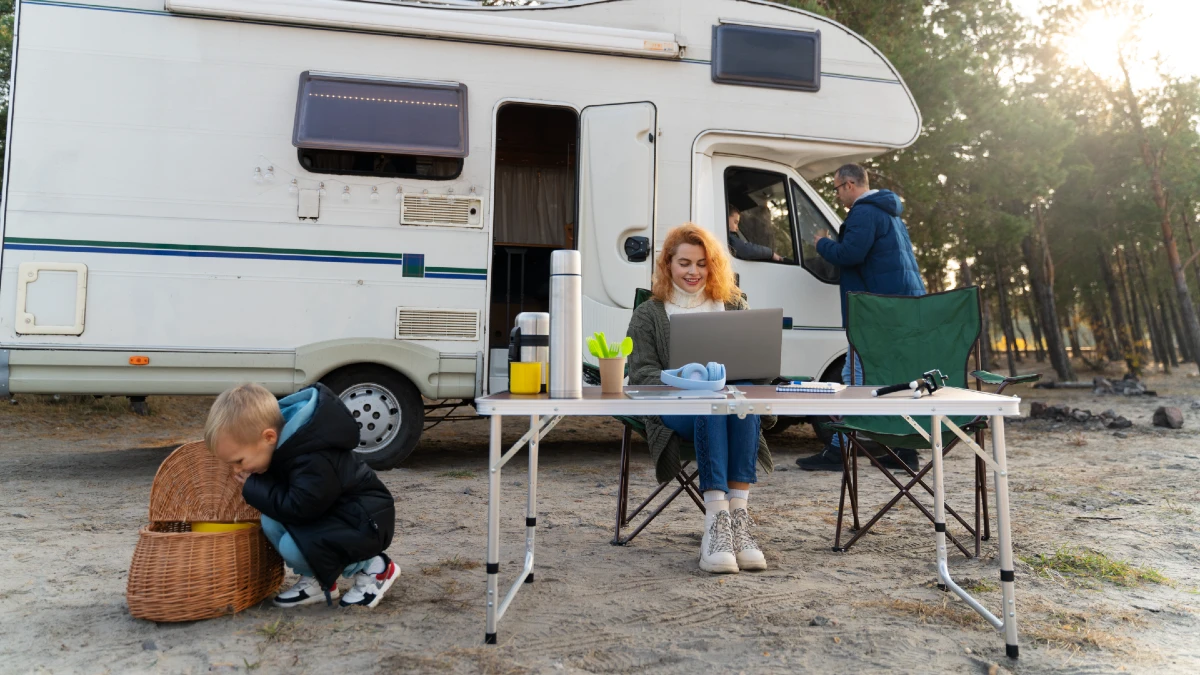RV life uncomfortable truths shatter dreams. Right now, you’re probably researching the RV lifestyle, watching YouTube videos of couples living their best nomadic life. You’re calculating how much money you’ll save without a mortgage.
Those same YouTubers are hiding massive repair bills, relationship breakdowns, and crushing isolation. That retired couple who sold their house for RV freedom? They’re now divorced and financially ruined.
The RV industry profits from your fantasies. They won’t tell you about $5,000 annual maintenance costs, or how weather controls your entire life, or why your dream RV becomes your worst nightmare.
These twelve brutal truths reveal what really happens when the Instagram filters come off. Read them before you make the costliest mistake of your life.
1. Your Dream RV Will Become Your Nightmare

Picture this: You’re backing your brand-new 45-foot fifth wheel into a campsite while twenty other campers watch, and you’ve already hit the picnic table twice. Sound familiar are the 1 reason why 40% of first-time RV buyers sell within two years.
The couple who bought that massive fifth wheel? They now hire professional drivers to move their RV because the towing stress and driving anxiety became unbearable. Every bridge clearance becomes a white-knuckle moment. Every gas station requires a 10-minute inspection to see if you’ll fit. RV towing challenges aren’t just about having the right truck—they’re about having the right nerves.
On the flip side, that adorable 16-foot travel trailer you thought would be perfect? Try washing a dinner plate in a sink the size of a cereal bowl. Small RV owners quickly discover that RV buying mistakes come in all sizes. Your romantic notion of “simple living” crumbles when you can’t even stand up straight in your own home.
Setup complexity issues multiply with size. Large RVs require leveling systems, slide-out adjustments, and utility connections that can take hours to perfect. Meanwhile, you’re blocking traffic and your slideout won’t retract because you parked on unlevel ground.
State parks across America have length restrictions that eliminate 60% of camping options for RVs over 35 feet. That dream trip to Yellowstone? Your big rig can’t fit in most campsites. RV size selection isn’t just about comfort—it’s about accessibility.
The bitter truth? There’s no perfect size. Go big, and you’ll curse every tight turn. Go small, and you’ll dream of counter space. Every RV is a compromise, and the compromise you make on paper rarely matches the reality of living with your choice 24/7. First-time buyers consistently underestimate how that size decision will control every aspect of their RV life journey.
2. You’re Not Actually Traveling That Much

Most full-time RV travel reality involves sitting in the same campground for weeks or months at a time. The average RVer moves every 2-3 weeks, not every day.
Budget constraints on constant movement hit hard when you realize that moving a 30-foot RV costs $200-400 in fuel alone. Add campground fees, and each move becomes a $300-500 expense. Multiply that by weekly moves, and you’re spending $1,500+ monthly just on relocation costs—before food, insurance, or maintenance.
Seasonal workers staying 3-6 months in one spot understand this reality. Amazon CamperForce workers park in Campbellsville, Kentucky for months. National park seasonal employees spend entire summers in the same location. The nomadic lifestyle becomes surprisingly stationary when you need steady income.
Work schedule restrictions compound the problem. Remote workers can’t hop between time zones randomly. Client meetings, deadlines, and internet connectivity requirements anchor you to reliable service areas. That spontaneous trip to a remote mountain lake? Not happening when you have a 9 AM video conference.
Weather delays and mechanical issues further limit travel frequency. Weather-related travel restrictions can strand RVers for days or weeks. Try driving through Kansas during tornado season or crossing the Rockies during a winter storm. Your travel schedule bends to Mother Nature’s whims.
The RV nomad lifestyle marketing promises constant adventure, but reality delivers long periods of routine punctuated by occasional moves. You’re not exploring new destinations daily—you’re doing laundry, grocery shopping, and handling the mundane tasks of life, just in a different zip code.
RV travel frequency becomes about survival, not adventure. Moving means planning, packing, driving stress, and setup hassles. Most RVers quickly settle into longer stays because constant movement is exhausting, expensive, and frankly, unsustainable for anyone trying to maintain work or relationships.
3. The Freedom Is Mostly an Illusion

That liberating feeling of hitting the open road. It disappears fast when you discover RV booking challenges require reservations 6-11 months in advance for desirable destinations. Popular destinations booked 11 months out means your “spontaneous” lifestyle follows everyone else’s predetermined schedule.
Budget constraints limiting choices create the cruelest freedom restriction. Sure, you can go anywhere—as long as it costs under $50 per night, has full hookups, and accepts your 35-foot rig. Suddenly, your “anywhere” becomes a very specific list of budget-friendly campgrounds in less-than-scenic locations.
RV travel limitations multiply when you factor in size restrictions. National parks with RV length limits eliminate half your bucket list destinations. Glacier National Park’s Going-to-the-Sun Road? Forget it. Yosemite Valley? Your rig won’t fit. The Grand Canyon? Maybe, if you can snag one of twelve suitable sites.
Work schedule limitations destroy the fantasy of work-life balance. Remote work requiring reliable internet zones chains you to cell towers and WiFi hotspots. That beautiful boondocking spot with zero connectivity? It’s off-limits when you have deadlines. Your freedom becomes a 50-mile radius around decent internet service.
Pet restrictions add another layer of RV lifestyle freedom limitations. Many campgrounds ban certain dog breeds or limit pet numbers. Some beaches prohibit dogs entirely. Your furry family members shrink your destination options further.
The RV booking challenges extend beyond availability. Cancellation policies are brutal—lose your deposit with 48 hours notice. Site assignments are lottery systems where you might get the spot next to the dumpster instead of the lake view you reserved.
Real RV lifestyle freedom means freedom to choose from a limited menu of expensive, crowded, size-restricted options that you must book nearly a year in advance. It’s freedom with more rules than your suburban HOA ever imposed.
4. Your Relationship Will Be Tested Like Never Before

It’s 2 AM, and your partner’s snoring is rattling the thin RV walls while you’re trying to work on a deadline. There’s literally nowhere to escape. Welcome to 24/7 togetherness strain in 200 square feet where privacy elimination becomes your new reality.
RV life relationships face unprecedented challenges when couples who previously spent 8-10 hours apart at work suddenly share every meal, every bathroom break, and every mood swing. Couples RV living means your partner witnesses your phone calls, overhears your private conversations, and knows exactly how long you spend in the bathroom.
Conflict resolution in 200 sq ft becomes an art form out of necessity. In a house, you could retreat to separate rooms to cool off. In an RV, you’re face-to-face whether you want to be or not. Decision-making pressure increases exponentially—every choice from where to park to what to eat requires consensus because you’re literally stuck together.
Divorce rates among new full-time RVers spike significantly in the first year. RV Facebook groups overflow with posts about couples therapy via video calls from RVs as relationships crumble under the pressure of constant proximity. Personal space elimination triggers claustrophobia in relationships that seemed solid in larger living spaces.
Many successful RV couples eventually invest in separate vehicle needs for mental health—a motorcycle, kayak, or even just different daily walking routes become essential for individual sanity. RV relationship challenges force couples to either develop superhuman patience and communication skills or watch their partnership implode.
The Instagram couples making it look easy? They’re either exceptional communicators or they’re fighting off-camera. Most relationships aren’t designed to survive sharing 200 square feet 24/7 without significant growing pains—or permanent damage.
5. Everything Breaks And It’s Expensive

Your slideout just stopped working in the middle of a rainstorm, and the repair estimate is $3,500. Welcome to the most expensive truth about RV ownership: everything breaks, and RV maintenance costs will destroy your budget faster than you can say “roadside assistance.”
Average annual RV maintenance ranges from $3,000-$5,000, but that’s for normal wear. Road vibration damage turns every mile into a potential repair bill. Cabinets separate from walls, appliances shake loose from their mounts, and plumbing connections fail from constant movement. Your home literally beats itself apart as you travel.
Water damage frequency tops insurance claim lists at 15% of all RV damage claims. One failed seal around a window or vent creates thousands in damage within days. Appliance failure rates in RVs exceed residential appliances by 300% due to vibration, voltage fluctuations, and space constraints.
RV repairs on the road cost 2-3 times shop rates. That $200 residential refrigerator repair becomes $600 when the technician drives 50 miles to your campground. RV breakdown expenses include not just repair costs but extended campground stays while waiting for parts—often adding $400-800 to every major repair.
Most common failure points include: water pumps (annual replacement), furnace boards ($300-500 annually), awning mechanisms, slide-out motors, and refrigerator cooling units. The RV industry builds for weight and space, not durability. Everything is lighter, cheaper, and more fragile than residential equivalents.
Mobile repair costs assume you’re desperate—because you are. Your home is broken, you can’t move, and you need it fixed immediately. Repair shops know this and price accordingly. Constant maintenance requirements mean something needs attention weekly, whether it’s seals, filters, batteries, or mechanical components.
Budget at least $400 monthly for maintenance and repairs—and that’s if you’re lucky. RVs aren’t homes that happen to move; they’re constantly failing machines that occasionally provide shelter.
6. Working From Your RV Is Harder Than It Looks

You’re on an important client call when your neighbor fires up their diesel generator at 8 AM sharp. Meanwhile, your internet cuts out because a cloud passed over your satellite dish. This is RV remote work reality—not the laptop-on-a-beach fantasy you see on social media.
Internet connectivity reality hits hard in remote areas. Starlink performance in remote areas degrades significantly during weather, peak usage hours, and when trees block satellite access. Campground WiFi limitations usually cap at 1-2 Mbps shared among 200+ RVs—unusable for video calls or large file uploads.
Weather affecting satellite internet creates workday chaos. Storms knock out satellite connections for hours. Wind moves your dish alignment. Heavy cloud cover reduces speeds by 80%. Your reliable internet becomes weather-dependent, making client commitments risky.
Noise from campground activities destroys professional calls. Children screaming at the playground, generators running, dogs barking, and RVs arriving create constant background chaos. Client call interruptions from neighbors include everything from loud music to chainsaws—because RV parks never truly quiet down.
No separation between work/life becomes mentally exhausting. Your office is your bedroom, kitchen, and living room. When work stress peaks, there’s nowhere to escape. Working from RV challenges include poor ergonomics at makeshift desks, lighting issues, and temperature control problems affecting productivity.
Generator hours restrictions limit work schedules. Most campgrounds prohibit generators during peak work hours or limit usage to 2-4 hours daily. RV internet connectivity requires multiple backup plans—cellular boosters, different carriers, and satellite options—costing $300+ monthly.
Professional RV remote work demands significantly higher internet budgets, backup power systems, and noise-canceling equipment. The freedom to work anywhere becomes the challenge of working reliably nowhere. Most RV workers eventually seek long-term sites near cell towers, defeating the nomadic lifestyle purpose entirely.
7. RV Parks Aren’t What You Expected

You reserved a “spacious, full-hookup site with scenic views,” but you’re now parked three feet from your neighbor’s bedroom window, staring at a dumpster while your sewer hose won’t reach the connection. Welcome to RV park quality reality—where marketing photos never match what you actually get.
Quality variation extremes shock first-time RVers. The same $60/night rate gets you either a pristine resort-style park or a gravel lot next to a highway truck stop. RV campground problems range from broken utilities to dangerous electrical hookups that could fry your RV’s systems without warning.
Sites too small for advertised RV sizes create nightmare scenarios. Your 35-foot RV barely fits in a “big rig friendly” site, with your slideouts extending into the roadway. Sewer hookup placement issues force you to buy 50 feet of hose extensions because the connection is inexplicably placed at the front of your site instead of near your RV’s waste outlet.
Overcrowding issues eliminate the peaceful camping experience you expected. Sites are packed so tightly that opening your door hits your neighbor’s awning. Neighbor proximity stress escalates when you hear every conversation, TV show, and bathroom visit from adjacent RVs through paper-thin walls.
Reservation bait-and-switch experiences happen constantly. You book a lakefront site six months ahead, only to arrive and find yourself assigned to a back-row spot near the maintenance shed. RV park booking issues include non-refundable deposits for sites that don’t exist as advertised.
Noise ordinance violations go unenforced at most parks. Generators run past quiet hours, parties continue until 2 AM, and barking dogs wake entire sections. Park management either doesn’t care or lacks authority to enforce their own rules, leaving paying customers trapped in chaos.
8. Your Health Could Become a Major Problem

Your chest pain starts at 3 AM in rural Montana, and the nearest hospital is 90 miles away with no cardiac specialist. This scenario illustrates why RV life healthcare becomes a terrifying gamble that most people don’t consider until it’s too late.
Healthcare provider access issues multiply in remote areas where you love to camp. Rural hospital capabilities often lack specialists, advanced imaging, or even 24-hour emergency services. That heart condition managed perfectly by your city cardiologist becomes a life-threatening crisis when you’re 200 miles from specialized care.
Prescription refill complications plague RVers constantly. Insurance networks don’t recognize out-of-state pharmacies. Medical care while RVing means explaining your complex medical history to new doctors every few months who don’t understand your treatment plan or medication interactions.
Emergency medical situations become exponentially more dangerous on the road. Ambulance response times in remote campgrounds often exceed 45 minutes. Medical equipment storage challenges mean your CPAP machine, oxygen concentrator, or dialysis supplies compete for space with your clothes and food.
Specialist appointment scheduling requires months of advance planning and often forces you to return to your home state. Insurance coverage gaps occur when your HMO only covers emergency care outside your network, leaving you with massive bills for routine specialist visits.
Telehealth limitations on the road include poor internet connectivity exactly when you need medical consultations most. Video appointments fail in remote areas where health problems often escalate due to limited local care options.
RV health insurance rarely covers the full cost of out-of-network emergency care, leaving RVers with surprise bills exceeding $50,000 for serious incidents. The freedom to roam becomes freedom from adequate medical care—a trade-off that can prove fatal.
9. The Hidden Costs Will Shock You

You budgeted $3,000 monthly for RV living, but you’re spending $4,800 and haven’t even bought groceries yet. Hidden RV living costs destroy budgets faster than a blown engine, and most people discover these expenses after they’ve already sold their house.
Fuel costs for large RVs average $800-1,200 monthly for moderate travel. A Class A motorhome getting 6-8 MPG turns every 300-mile move into a $120-200 fuel expense. Fuel consumption rates by RV type range from 25 MPG for small travel trailers to 6 MPG for luxury diesel pushers—a brutal reality when gas hits $4+ per gallon.
Campground fee inflation averages 15% annually, with desirable parks now charging $80-120 nightly. Average monthly RV living costs exceed $4,000 for most couples when you factor in campground fees ($1,800), fuel ($1,000), food ($600), insurance ($200), maintenance ($400), and storage ($200).
Eating out frequency increases dramatically without full kitchens and meal prep space. Restaurant meals cost RVers 40% more than home cooking, adding $300-500 monthly to food budgets. Laundromat expenses average $60-80 monthly since most RVs lack washers and dryers.
Storage unit rentals become essential for seasonal items, tools, and belongings that don’t fit in RVs. These cost $100-300 monthly depending on location and size needs. RV lifestyle expenses include propane ($80/month), dump station fees ($10-20 per use), and WiFi boosters ($300+ for reliable internet).
Campground price increases year-over-year have outpaced inflation by 200% in popular destinations. That $35/night park from five years ago now charges $75, destroying long-term budget projections.
The cruel irony Full-time RV budget calculations assume you’ll spend less than traditional housing, but most RVers spend 20-30% more while sacrificing space, comfort, and stability.
10. Weather Will Control Your Life

Hurricane Florence is bearing down on the Carolina coast, and you’re frantically trying to evacuate a 40-foot motorhome with 24 hours’ notice. Hurricane evacuation logistics become nightmarish when your home weighs 20,000 pounds and needs special fuel stops every 200 miles.
RV weather challenges dictate every aspect of your life. Winter heating costs and challenges skyrocket when you’re running propane furnaces in subzero temperatures. Propane consumption in cold weather can exceed $300 monthly, while frozen water lines and burst pipes create thousands in damage overnight.
Desert summer limitations trap RVers in air-conditioned prisons. Air conditioning electrical demands overwhelm RV electrical systems, forcing expensive campground stays for 30-amp or 50-amp power. Running AC units 24/7 in Arizona heat costs $200+ weekly in electrical hookup fees alone.
Seasonal migration requirements force constant movement based on weather patterns. RV seasonal living means following a rigid schedule—north in summer, south in winter—eliminating spontaneity from the “freedom” lifestyle. Miss your migration window, and you’re trapped in dangerous conditions.
Storm damage risks multiply when your home sits on tires instead of a foundation. Storm shelter limitations leave RVers vulnerable during tornadoes, hurricanes, and severe thunderstorms. Most RV parks lack adequate storm shelters, leaving residents to huddle in bathroom facilities or flee.
RV climate control systems fail regularly under extreme conditions. Furnaces quit in blizzards, AC units die in heat waves, and you’re left with no backup systems. Weather becomes your master, dictating where you can go, when you can travel, and how much you’ll spend surviving Mother Nature’s whims.
11. Social Isolation Is Real

You’re watching your granddaughter’s first steps on a grainy FaceTime call from a Walmart parking lot while fighting back tears. RV life isolation hits hardest during life’s precious moments that you can no longer share in person.
Leaving family and friends behind creates profound loneliness that social media can’t cure. Missing grandchildren’s milestones becomes the hidden cost of constant travel. Birthday parties, school plays, and family gatherings become virtual-only family gatherings when you’re 2,000 miles away in your “freedom machine.”
Difficulty maintaining relationships intensifies when you’re always the one who has to travel back for important events. Friends stop calling because you’re never available for spontaneous plans. RV social challenges multiply when your closest relationships become screen-based interactions limited by poor internet connectivity.
Making new friends challenges prove harder than expected. Temporary friendship nature characterizes most RV relationships—you meet lovely people, share a few weeks together, then never see them again. Deep, lasting friendships require time and proximity that nomadic living eliminates.
Community involvement barriers prevent the sense of belonging that humans crave. You can’t join local organizations, volunteer regularly, or build the community connections that provide meaning and purpose. Church attendance becomes sporadic. Local activities remain off-limits because you’re always temporary.
Holiday celebration changes hit particularly hard. Christmas in a campground lacks the warmth of family traditions. Thanksgiving becomes a lonely meal for two instead of gathering with extended family. RV community connections rarely replace the depth of long-term neighborhood relationships and family bonds you’ve left behind.
12. You Can’t Escape Yourself

Three months into RV life, you realize your anxiety hasn’t disappeared—it’s gotten worse. That depression you thought would lift with a change of scenery It followed you into your 250-square-foot rolling home, along with every other personal issue you were trying to escape.
Personal problems travel with you regardless of your zip code. RV life mental health challenges intensify when you’re isolated from familiar support systems. Lifestyle change doesn’t fix internal issues—it often amplifies them under the stress of constant adaptation and decision-making.
Depression and anxiety continuation becomes more dangerous on the road. Therapy continuation challenges multiply when you’re constantly changing locations and internet connectivity remains unreliable for telehealth appointments. Finding new mental health providers every few months disrupts treatment continuity exactly when you need stability most.
Relationship problems magnification occurs in the pressure cooker of 24/7 togetherness. That communication issue you had at home? It explodes in an RV where there’s no space to cool off. Financial stress follows location changes—in fact, it usually gets worse as hidden costs destroy your budget.
Substance abuse risks in isolation increase dramatically. Alcohol becomes an easy escape from RV life stress, and there’s no workplace accountability or social oversight to provide checks and balances. Financial debt reality checks crush the fantasy when credit cards max out three months in.
The harshest truth RV lifestyle expectations assume that changing your environment changes your fundamental self. It doesn’t. Personal growth RV life requires the same internal work whether you’re parked in a driveway or a desert. You can’t drive away from yourself—your problems ride shotgun.
Conclusion
These RV life uncomfortable truths aren’t meant to crush your dreams—they’re meant to save you from crushing disappointment and financial disaster. RV life absolutely can be rewarding for the right people with realistic RV living expectations, adequate budgets, and strong relationships.
The couples thriving in RVs? They tested their compatibility in small spaces first, built substantial emergency funds, and understand that “freedom” means trading house problems for road problems. They didn’t quit their jobs and sell everything based on Instagram fantasies.
Before you make irreversible life changes, start with short-term RV rentals. Rent different sizes and types. Travel in bad weather. Work from campgrounds with poor WiFi. Experience the reality of dumping tanks, dealing with breakdowns, and living in each other’s pockets for weeks.

